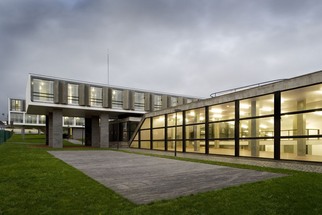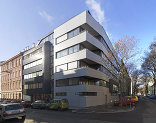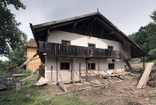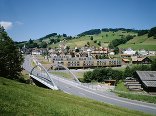Bauwerk
University Residences of Laranjeiras
a.S* - Ponta Delgada (P) - 2007

University residences of Laranjeiras
Responding to a desire for freedom in built space, a.S* built a family of blocks with different personalities.
16. April 2008 - Carlos Sant’Ana
Looking back at recent history, we could say 1998 was a good year for Portugal. Lisbon Expo98 was a successful model for a world exhibition in combination with urban renewal. Saramago won the Nobel Prize for Literature, demonstrating the quality of Portuguese literature to the world. Economic growth was strong and EU funds were proving a blessing for a still emerging economy. There were also many architectural competitions around this time and, to top it all off, the Oporto School graduated a clutch of unusually innovative architects. Between 1997 and 1999 this group of young, unknown architects won four competitions in a row in the Azores, making a generational statement about a new approach to architectural design in Portugal.
1998 was a good year for a.S*. Their Laranjeiras University Residence Complex is one of the projects that brought optimism to Portuguese architecture, then dominated by boring „critical regionalism“. Its mixture of Dutch-style interdisciplinary design and a pop culture-inspired method became a turning point in architectural design in Portugal.
The site of this project which would „turn out to be an opportunity to create an urban structure that could be a guide for future interventions“ was on the outskirts of Ponta Delgada in S.Miguel, Azores, between an old industrial zone and a former agricultural area turned homogeneous suburb. The brief called for accommodation for 300 students. The architects began with a playful confrontation between the buildings and the landscape, developing a variety of abstract typologies that eventually matured into a set of buildings with distinct personalities.
Landscape became the central element of the design strategy, acquiring its public dimension between the blocks. The various functions were grouped according to their relative importance in the overall project and their potential as a stage for public activities. The „Car Parking Strip“ and „Urban Stroll Strip“ are located parallel to the road as connectors for inhabitants and passers-by, while the „Green Strip“ establishes the visual interface with the interior of the complex. The „Central Park Strip“ organizes circulation within the complex and connects buildings, while the „Events Strip“ contains supporting functions such as an orange grove, playing field, garden and lovers’ labyrinth, bicycle park and, at the end, the „Canada“ (a rural path) and „Meadow Strip“, an enormous multi-purpose green field.
The complex consists of four separate longitudinal blocks laid parallel between the landscape strips and perpendicular to the main access to Ponta Delgada. A fifth block acts as the main entrance to the complex and contains a cafetaria and canteen, a belvedere and a solarium and the students’ common room. This last building is in fact an extension of the landscape and public space. The blocks develop as variations on the minimum unit, a double room. On the south side there are full-height windows opening on to the rooms’ outdoor space; access to the units is from the north side. The room interiors are also organized in parallel zones: entrance, study, bathroom, bedroom. The bathroom zone contains a bookshelf and a closet the doors of which can be used to divide the space and to provide a measure of privacy to the sleeping area.
The four buildings are obviously related but also different as a result of slight variations – the addition of verandas, different floor levels, et cetera – and their relationship to the surrounding landscape. The southern block is the „Fearless Building“ because it faces all the people coming from the city centre. The second one is simply „Building 2“ while the block closest to the sports area is the „Sporting Building“ and the largest block is the „Solid Building“. The aptly named „Central Building“ is in the centre of the residential blocks and the landscape strips. Inside the blocks, circulation, whether vertical, horizontal or oblique, is on the north side. Students are allowed to choose the block (=personality) and the room (=view) they want to live in.
As the architects said in a recent interview, „There is a desire for freedom that evidences itself in both the work process and in the built space. It’s not only about use, but also, maybe even more, about behaviour.“ It is precisely their innovation, creativity and professional behaviour that makes a.S* a reference point for young architects in Portugal.
1998 was a good year for a.S*. Their Laranjeiras University Residence Complex is one of the projects that brought optimism to Portuguese architecture, then dominated by boring „critical regionalism“. Its mixture of Dutch-style interdisciplinary design and a pop culture-inspired method became a turning point in architectural design in Portugal.
The site of this project which would „turn out to be an opportunity to create an urban structure that could be a guide for future interventions“ was on the outskirts of Ponta Delgada in S.Miguel, Azores, between an old industrial zone and a former agricultural area turned homogeneous suburb. The brief called for accommodation for 300 students. The architects began with a playful confrontation between the buildings and the landscape, developing a variety of abstract typologies that eventually matured into a set of buildings with distinct personalities.
Landscape became the central element of the design strategy, acquiring its public dimension between the blocks. The various functions were grouped according to their relative importance in the overall project and their potential as a stage for public activities. The „Car Parking Strip“ and „Urban Stroll Strip“ are located parallel to the road as connectors for inhabitants and passers-by, while the „Green Strip“ establishes the visual interface with the interior of the complex. The „Central Park Strip“ organizes circulation within the complex and connects buildings, while the „Events Strip“ contains supporting functions such as an orange grove, playing field, garden and lovers’ labyrinth, bicycle park and, at the end, the „Canada“ (a rural path) and „Meadow Strip“, an enormous multi-purpose green field.
The complex consists of four separate longitudinal blocks laid parallel between the landscape strips and perpendicular to the main access to Ponta Delgada. A fifth block acts as the main entrance to the complex and contains a cafetaria and canteen, a belvedere and a solarium and the students’ common room. This last building is in fact an extension of the landscape and public space. The blocks develop as variations on the minimum unit, a double room. On the south side there are full-height windows opening on to the rooms’ outdoor space; access to the units is from the north side. The room interiors are also organized in parallel zones: entrance, study, bathroom, bedroom. The bathroom zone contains a bookshelf and a closet the doors of which can be used to divide the space and to provide a measure of privacy to the sleeping area.
The four buildings are obviously related but also different as a result of slight variations – the addition of verandas, different floor levels, et cetera – and their relationship to the surrounding landscape. The southern block is the „Fearless Building“ because it faces all the people coming from the city centre. The second one is simply „Building 2“ while the block closest to the sports area is the „Sporting Building“ and the largest block is the „Solid Building“. The aptly named „Central Building“ is in the centre of the residential blocks and the landscape strips. Inside the blocks, circulation, whether vertical, horizontal or oblique, is on the north side. Students are allowed to choose the block (=personality) and the room (=view) they want to live in.
As the architects said in a recent interview, „There is a desire for freedom that evidences itself in both the work process and in the built space. It’s not only about use, but also, maybe even more, about behaviour.“ It is precisely their innovation, creativity and professional behaviour that makes a.S* a reference point for young architects in Portugal.
Für den Beitrag verantwortlich: A10
Ansprechpartner:in für diese Seite: Hans Ibelings












